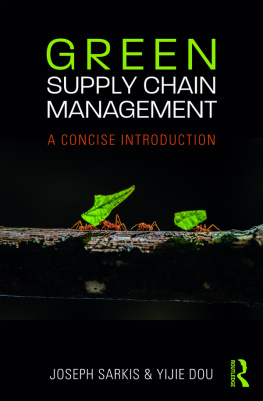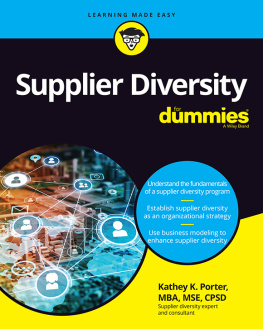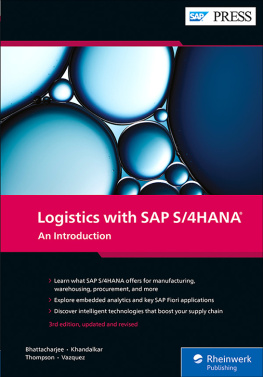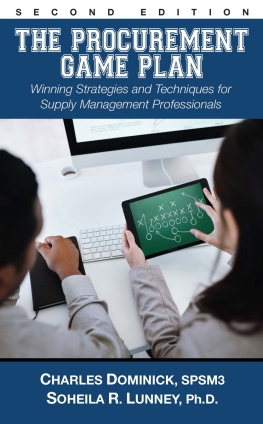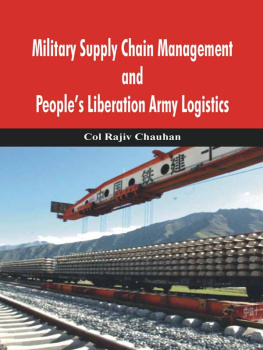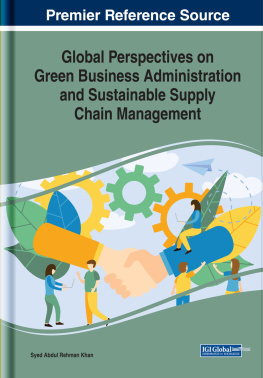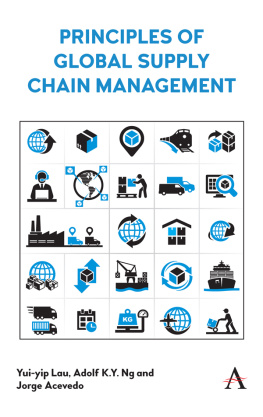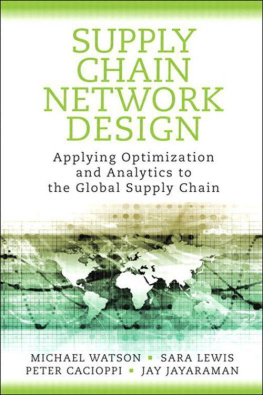First published 2018
by Routledge
711 Third Avenue, New York, NY 10017
and by Routledge
2 Park Square, Milton Park, Abingdon, Oxon, OX14 4RN
Routledge is an imprint of the Taylor & Francis Group, an informa business
2018 Taylor & Francis
The right of Joseph Sarkis & Yijie Dou to be identified as authors of this work has been asserted by them in accordance with sections 77 and 78 of the Copyright, Designs and Patents Act 1988.
All rights reserved. No part of this book may be reprinted or reproduced or utilized in any form or by any electronic, mechanical, or other means, now known or hereafter invented, including photocopying and recording, or in any information storage or retrieval system, without permission in writing from the publishers.
Trademark notice: Product or corporate names may be trademarks or registered trademarks, and are used only for identification and explanation without intent to infringe.
Library of Congress Cataloging-in-Publication Data
Names: Sarkis, Joseph, author, | Dou, Yijie, author.
Title: Green supply chain management : a concise introduction / Joseph
Sarkis & Yijie Dou.
Description: 1 Edition. | New York : Routledge, 2017.
Identifiers: LCCN 2017022212 | ISBN 9781138292321 (hbk) |
ISBN 9781138302815 (pbk) | ISBN 9781315233000 (ebk)
Subjects: LCSH: Business logisticsEnvironmental aspects. | Industrial
managementEnvironmental aspects.
Classification: LCC HD38.5 .S275 2017 | DDC 658.7dc23
LC record available at https://lccn.loc.gov/2017022212
ISBN: 978-1-138-29232-1 (hbk)
ISBN: 978-1-138-30281-5 (pbk)
ISBN: 978-1-315-23300-0 (ebk)
Typeset in Bembo
by Apex CoVantage, LLC
Contents
Guide
7
Global and Local Relationships
International supply chain management is a critical aspect of managing the supply chain. Global strategies and operations within the context of greening the supply chain are considered in this chapter. The overall viewpoint of these multilevel relationships and flows are described. How internationalization, multinational enterprises, and various international management dimensions play a role will be a focus. The major topics and sections in this chapter are as follows:
- Globalization theory and relationships to green supply chains
- Drivers for globalization and their relationship to greening supply chains
- Levels of analysis for green supply chains
- A boundaries perspective
Globalization and the Natural Environment
Globalization and internationalization are two terms that are typically used interchangeably. Essentially globalization refers to trade or supply chains that flow across international borders, with globalization assumed to occur in different regions of the world.
The globalization of supply chains has occurred for a variety of reasons. More countries have started to join the World Trade Organization (WTO), thereby reducing various trade barriers. Companies seek international locations for a variety of reasons, including seeking a comparative advantage in local regions, whether these advantages have to do with natural resources, cost, labor, or regulation, as examples.
Globalization Theory
A number of theoretical perspectives are used to explain why organizations may globalize. Three of the more popular ones are Vernons (Vernon, 1966) international expansion, foreign direct investment strategy; Dunnings eclectic paradigm (Dunning, 1977), and the Uppsala model (Johanson and Wiedersheim-Paul, 1975). Each has some greening supply implications, with an example or two presented.
Vernon (1966) argued that four expansion stages for U.S. firms exist. The theory linked foreign direct investment decisions to economic rationality over a product life cycle. For a products introductory stage, given uncertain sales growth, an organization uses excess domestic productive capacity to produce and export to other developed economies. As products mature, organizations increase exports to developing economies as they seek to grow their market share. As the product reaches a maturity stage and growth levels off, cost efficiencies are sought to increase margins; the organization may then use improved process technologies and produce more abroad, exporting less. It is argued that manufacturing abroad will likely occur first in other developed countries for export to developing countries. At the product decline phase of the product life cycle, most production moves to lesser developed economies for worldwide distribution. This process makes a number of assumptions but can have an impact on the greening of supply chains. An example of this process of having an impact is that planning for globalization may need to take into consideration developed country regulations and pressures that can be transferred to developing countries. Thus, the diffusion of green standards can likely occur as organizations standardize processes and policies no matter which economy they encounter. It is unclear whether cost reduction phases also mean searching for locations where environmental regulatory policy is weak so that polluting without incurring externality costs is achievedthe pollution haven hypothesis.
One of the most visible theories within internationalization is Dunnings eclectic theory, or paradigm, for foreign entry decisions (Dunning, 1977). A major aspect of this theory is that ownership, location, and internalization (OLI) advantages will influence an organizations globalization. Ownership advantages refer to product, design, patent, trade secret, and resources advantages that may overcome the cost savings that could be had in a foreign country. Examples are production techniques, licenses, and trademarks. If there are ownership advantages, a firm may wish to keep production and control internal, although they still may be located overseas, and in facilities owned by the firm. Location advantages may relate to whether a particular region has advantages over domestic locations, such as lower labor costs, easier access to resources, or better infrastructure. Internalization advantages relate to whether an organization wishes to operate in a foreign country using a wholly owned subsidiary, exporting, licensing, or joint ventures. Joint ventures and licensing with respect to environmental technologies may play a role in this theoretical perspective.
The Uppsala model specifies that organizations go through a series of stages in the globalization process as more information is gained and risk is reduced. The Uppsala model stipulates that organizations internationalize as experience and knowledge of foreign markets are gained. Because learning is usually acquired slowly, internationalization can be viewed as an incremental process of four stages. Each internationalization stage is based on the knowledge gained in a previous stage. In the first stage, with limited knowledge on international markets gained, firms are not engaged in export activities. The second stage involves intermediaries who are hired to facilitate exporting. Interactions with the intermediaries aid in knowledge acquisition about foreign markets. The third stage involves a sales and distribution subsidiary taking advantage of the knowledge gained. Eventually in the latest stage, the organization establishes its own foreign production facility. At each level, there is more involvement in foreign locations by the organization. From an environmental perspective, this process means that the organization tends also to increase its influence on the environmental performance of facilities and the supply chain. For example, serving only as a distribution center limits the environmental resources used in a region. The control of green supply chain activities with an intermediary is more difficult than if the source of production is directly owned by an organization. Thus, it is expected that firms will be in better control of international supply chain greening efforts as it matures in the Uppsala model.

